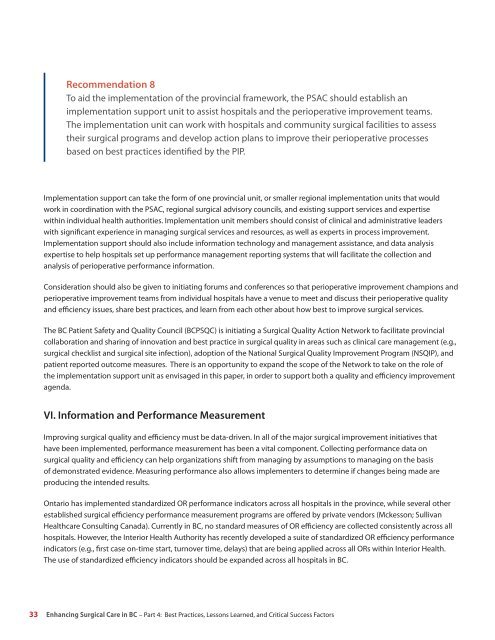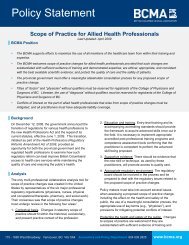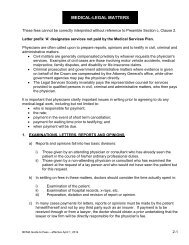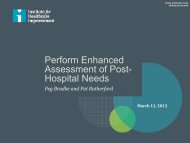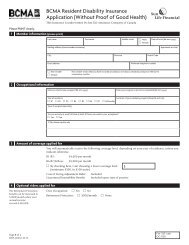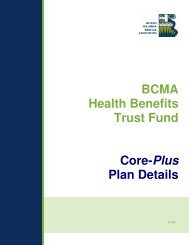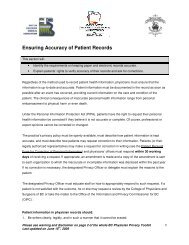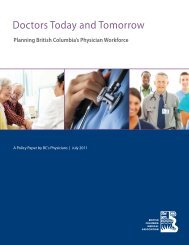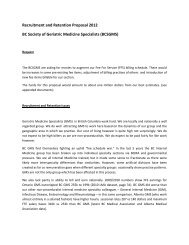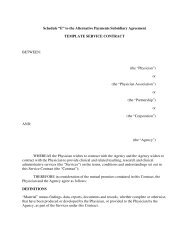Enhancing Surgical Care in BC - British Columbia Medical Association
Enhancing Surgical Care in BC - British Columbia Medical Association
Enhancing Surgical Care in BC - British Columbia Medical Association
You also want an ePaper? Increase the reach of your titles
YUMPU automatically turns print PDFs into web optimized ePapers that Google loves.
Recommendation 8<br />
To aid the implementation of the prov<strong>in</strong>cial framework, the PSAC should establish an<br />
implementation support unit to assist hospitals and the perioperative improvement teams.<br />
The implementation unit can work with hospitals and community surgical facilities to assess<br />
their surgical programs and develop action plans to improve their perioperative processes<br />
based on best practices identified by the PIP.<br />
Implementation support can take the form of one prov<strong>in</strong>cial unit, or smaller regional implementation units that would<br />
work <strong>in</strong> coord<strong>in</strong>ation with the PSAC, regional surgical advisory councils, and exist<strong>in</strong>g support services and expertise<br />
with<strong>in</strong> <strong>in</strong>dividual health authorities. Implementation unit members should consist of cl<strong>in</strong>ical and adm<strong>in</strong>istrative leaders<br />
with significant experience <strong>in</strong> manag<strong>in</strong>g surgical services and resources, as well as experts <strong>in</strong> process improvement.<br />
Implementation support should also <strong>in</strong>clude <strong>in</strong>formation technology and management assistance, and data analysis<br />
expertise to help hospitals set up performance management report<strong>in</strong>g systems that will facilitate the collection and<br />
analysis of perioperative performance <strong>in</strong>formation.<br />
Consideration should also be given to <strong>in</strong>itiat<strong>in</strong>g forums and conferences so that perioperative improvement champions and<br />
perioperative improvement teams from <strong>in</strong>dividual hospitals have a venue to meet and discuss their perioperative quality<br />
and efficiency issues, share best practices, and learn from each other about how best to improve surgical services.<br />
The <strong>BC</strong> Patient Safety and Quality Council (<strong>BC</strong>PSQC) is <strong>in</strong>itiat<strong>in</strong>g a <strong>Surgical</strong> Quality Action Network to facilitate prov<strong>in</strong>cial<br />
collaboration and shar<strong>in</strong>g of <strong>in</strong>novation and best practice <strong>in</strong> surgical quality <strong>in</strong> areas such as cl<strong>in</strong>ical care management (e.g.,<br />
surgical checklist and surgical site <strong>in</strong>fection), adoption of the National <strong>Surgical</strong> Quality Improvement Program (NSQIP), and<br />
patient reported outcome measures. There is an opportunity to expand the scope of the Network to take on the role of<br />
the implementation support unit as envisaged <strong>in</strong> this paper, <strong>in</strong> order to support both a quality and efficiency improvement<br />
agenda.<br />
VI. Information and Performance Measurement<br />
Improv<strong>in</strong>g surgical quality and efficiency must be data-driven. In all of the major surgical improvement <strong>in</strong>itiatives that<br />
have been implemented, performance measurement has been a vital component. Collect<strong>in</strong>g performance data on<br />
surgical quality and efficiency can help organizations shift from manag<strong>in</strong>g by assumptions to manag<strong>in</strong>g on the basis<br />
of demonstrated evidence. Measur<strong>in</strong>g performance also allows implementers to determ<strong>in</strong>e if changes be<strong>in</strong>g made are<br />
produc<strong>in</strong>g the <strong>in</strong>tended results.<br />
Ontario has implemented standardized OR performance <strong>in</strong>dicators across all hospitals <strong>in</strong> the prov<strong>in</strong>ce, while several other<br />
established surgical efficiency performance measurement programs are offered by private vendors (Mckesson; Sullivan<br />
Healthcare Consult<strong>in</strong>g Canada). Currently <strong>in</strong> <strong>BC</strong>, no standard measures of OR efficiency are collected consistently across all<br />
hospitals. However, the Interior Health Authority has recently developed a suite of standardized OR efficiency performance<br />
<strong>in</strong>dicators (e.g., first case on-time start, turnover time, delays) that are be<strong>in</strong>g applied across all ORs with<strong>in</strong> Interior Health.<br />
The use of standardized efficiency <strong>in</strong>dicators should be expanded across all hospitals <strong>in</strong> <strong>BC</strong>.<br />
33 <strong>Enhanc<strong>in</strong>g</strong> <strong>Surgical</strong> <strong>Care</strong> <strong>in</strong> <strong>BC</strong> – Part 4: Best Practices, Lessons Learned, and Critical Success Factors


